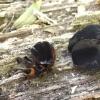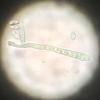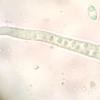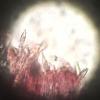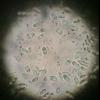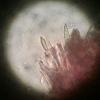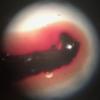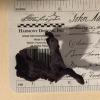
26-09-2019 05:23
Ethan CrensonHello all, I was on a walk last Sunday in the Bro

02-10-2019 13:38
Carbone MatteoDear all,sorry to bother you. Maybe Zotto can help

02-10-2019 13:09
 Yatsiuk Iryna
Yatsiuk Iryna
Hello!This specimen, which to me looks like Iodoph

26-09-2019 22:47
 Stip Helleman
Stip Helleman
Dear friends, Dr Ricardo Galan asked me to upload

30-09-2019 19:17
 Edmond POINTE
Edmond POINTE
Bonsoir a tous,Récolté sur crotte de mouton à J

30-09-2019 20:09
Growing on a thiny branch of Pterospartum tridenta

25-09-2019 23:25
 Rubén Martínez-Gil
Rubén Martínez-Gil
Hola a todos. Subo unas fotos de una Peziza que e
Ionomidotis irregularis ?
Ethan Crenson,
26-09-2019 05:23
Hello all,
I was on a walk last Sunday in the Bronx, NYC where a friend of mine found a very interesting asco. It has a black fertile surface. The outer surface is scurfy and dark brown. It is rather thin and papery, especially after drying. It was growing on deciduous wood. Asci that I measured were 70-73 x 6.5-7.5µm. Spores are hyaline, biguttulate, ellipsoid and 7-10.5 x 3-4µm. Paraphyses are lanceolate, septate, they enlarge to about 4µm at the widest point. Many of the heads of the paraphyses became detached. I applied KOH and noticed that there was an exudate of dark red pigment. It also appears to be bitunicate. (Unfortunately I am having problems with my image capture equipment, so I don't have the best documentation of all of these features). Is this Ionomidotis irregularis?
Many thanks in advance for your help.
Ethan
Hans-Otto Baral,
26-09-2019 09:19

Re : Ionomidotis irregularis ?
Hi Ethan
this is undoubtedly I. irregularis. Did you try to find out which wood it is? I know it only from Fagus, but for China is also Betula indicated.
What is the diameter of the apos? The asci are not bitunicate, they only have an inamyloid apical wall thickening.
I would appreciate the collection data to be cited in my planned paper on this species and the similar Diplocarpa bloxamii.
Zotto
this is undoubtedly I. irregularis. Did you try to find out which wood it is? I know it only from Fagus, but for China is also Betula indicated.
What is the diameter of the apos? The asci are not bitunicate, they only have an inamyloid apical wall thickening.
I would appreciate the collection data to be cited in my planned paper on this species and the similar Diplocarpa bloxamii.
Zotto
Ethan Crenson,
26-09-2019 15:29
Re : Ionomidotis irregularis ?
Thank you Zotto! The collection was on a large cut stump in the Hunter Island section of Pelham Bay Park in the Bronx. Although Betula exists in the park, there are very few and they certainly do not grow as large as the stump in question. Fagus and Quercus are dominant in the park along with Liquidambar, Robinia and Liriodendron.
The smaller cluster of apothecia are 1.5 cm wide x 1.5 cm high. The larger spreads to 4cm at the widest point and is 1.5 cm tall. It was collected by Leah Krauss on September 22, 2019 at approximately 40.872817, -73.790911
Please let me know if there is any other data I can provide about the collection for your paper. I'm happy to help.
Ethan
Gernot Friebes,
26-09-2019 17:43
Re : Ionomidotis irregularis ?
Hi, Ethan & Zotto,
this species was found on Populus by A. Gallé a few years ago, the collection data can be seen in austria.mykodata.net.
T. Glaser also recently published an article on I. irregularis in Mycologia Bavarica 19.
Best wishes,
Gernot
this species was found on Populus by A. Gallé a few years ago, the collection data can be seen in austria.mykodata.net.
T. Glaser also recently published an article on I. irregularis in Mycologia Bavarica 19.
Best wishes,
Gernot
Hans-Otto Baral,
26-09-2019 20:20

Re : Ionomidotis irregularis ?
Thanks, this is a big size for an inoperculate!
Quercus and Fagus are easily distinguished with a handlens (ring-pored in Quercus).
Hi Gernot, thanks for the hint on the paper (I do not have access) and the sample on Populus. This was certainly Populus already in the field?
Quercus and Fagus are easily distinguished with a handlens (ring-pored in Quercus).
Hi Gernot, thanks for the hint on the paper (I do not have access) and the sample on Populus. This was certainly Populus already in the field?
Gernot Friebes,
26-09-2019 20:26
Re : Ionomidotis irregularis ?
Populus was certain according to Anna. I don't have Thomas' article digitally either but I am sure he would send it to you if you ask him.
Best wishes,
Gernot
Best wishes,
Gernot
Patrice TANCHAUD,
26-09-2019 22:20
Re : Ionomidotis irregularis ?
Please, how to separate I. fulvotingens ?
Many thanks.
Patrice
Many thanks.
Patrice
Hans-Otto Baral,
26-09-2019 23:16

Re : Ionomidotis irregularis ?
That species has neither lanceolate paraphyses nor hairs, and the spores are much smaller.
Patrice TANCHAUD,
27-09-2019 00:40
Re : Ionomidotis irregularis ?
Merci Zotto.
Ethan Crenson,
02-10-2019 17:00
Hans-Otto Baral,
02-10-2019 17:04

Re : Ionomidotis irregularis ?
o.k, thanks.
Hans-Otto Baral,
02-10-2019 17:04

Re : Ionomidotis irregularis ?
o.k, thanks.


